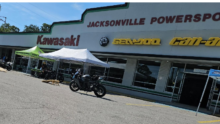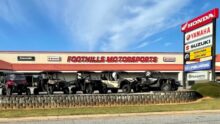Planning your dealership’s exit or succession in today’s environment
This article was written by Brad Stanek and Paulina Matel
We have clearly reached an inflection point in the powersports industry. The economy has held up better than many of us expected, but higher interest rates and general uncertainty have slowed the powersports business after years of unprecedented profitability. What does that mean for the value of your dealership? Is the window closing on exit opportunities?
George Chaconas, senior partner of the National Harley-Davidson & Powersports Dealerships Division of Performance Brokerage Services, told us on a recent webinar we hosted that he’s seeing more sellers than ever entering the market. Meanwhile, he says buyers are slowing their pace of acquisitions because dealer profitability is down, they have more sellers to choose from and higher interest rates are having a negative effect on dealership valuations and related real estate. Despite this, it’s not all bad news for dealers looking to sell.
Opportunities remain for buyers and sellers
Chaconas believes now can still be a good time to consider exiting. A lot of money remains on the sidelines and today’s buyers tend to have strong balance sheets. That bodes well for sellers. Meanwhile, it’s a great time to be a buyer, Chaconas notes, because there are far more dealerships available than there were during the pandemic when dealers wanted to keep riding the wave of money, rather than exit. “Now our dealer clients are normalizing to those numbers, so it’s still very tricky to value these businesses,” he says.
Chaconas advises buyers to do their own pro formas so they can “back into a number that they’re comfortable with” based on the ROI they’re mandated to get. “We feel 2024 will still be a very active year and we’re excited to help both buyers and sellers,” Chaconas says.
Near-term economic forecast and impact on dealerships
Paulina Matel, CFP, Financial Advisor for the Stanek-Haack Group at Morgan Stanley states that Morgan Stanley’s outlook for 2024 leans toward a soft landing prediction with only a 30 percent chance of recession. “We’re expecting muted GDP growth with inflation continuing to fall amid a more accommodative monetary policy from the Fed,” Matel says. “Typically, that would mean lower interest rates starting at some point in 2024,” which generally bodes well for both buyers and sellers.
Matel cautions dealers not to count on a huge economic rebound to ignite dealer profits and valuations like the industry saw in 2021 or 2022. “Your value will have to come the traditional way,” Matel says, “from a solid marketing plan, from adding lines acquisitions and from other things you may have more control over internally as an owner.”
And if the markets soften, Matel suggests that dealers build out their pro forma financial statements. “This will allow you to compare your dealership’s worth today to what it might be worth a few years out. Then you can determine whether it makes sense for you to stay at the helm for a few more years.”
Dealership valuation considerations
Chaconas’ colleague, Courtney Bernhard, a partner at Performance Brokerage, says buyers, sellers and advisors alike are finding it challenging to make valuation calculations today. This is because the Covid-year numbers are in the middle of the five-year period buyers typically use to assess a seller’s “normalized” performance. She believes buyers are putting less weight on performance during Covid−19 and realizing the market is normalizing. So, most buyers are looking back as far as 2018 to get a better sense of a dealer’s historical performance, according to Bernhard.
“There’s both an art and science to valuing dealerships,” Bernhard says. “We’re taking into consideration many factors that affect a dealership’s performance, past and present when preparing our valuation and know that a buyer will also do their own pro forma. Chaconas went on to say that multiline dealerships are still doing very well but “we are beginning to see pressure from the OEMs for dealership performance and to bring the dealership to image compliance.”
In my experience, a dealership’s value is composed of several key buckets including cash, multiple of cash flow, short-term assets such as inventory, furniture, fixtures and equipment and liabilities. Then it’s a matter of determining how those different components fit together.
When it comes to goodwill, Bernhard says you must consider the value of a dealer’s location, reputation and franchises under one roof. “Once we arrive at the goodwill number and come to an agreement on it, then everything else falls in line,” she says. “When talking to dealers about goodwill, they sometimes have an arbitrary number in their head that they may have got from a local broker who may not have much if any experience in pricing dealerships. Everything has inherent value – furniture, fixtures and equipment, plus other assets sitting on a depreciation schedule. Each dealer depreciates those items differently. These are things we can negotiate.”
According to Bernhard, dealers should also look closely at parts, accessories and general merchandise. “I’m passionate about this part of the dealership because it’s typically overlooked and never up to date,” she adds. “There’s a lot of money sitting in parts. But with parts becoming obsolete faster than before, buyers are becoming more conservative when it comes to valuing parts you have in inventory. Sellers should do an annual physical inventory and take advantage of any tax write-offs for obsolescence.”
Company vehicles and trailers also come into play. “Often, the vehicles and trailers sit on a depreciation schedule, but we negotiate those items separately and make sure no stone is left unturned,” Bernhard says. And major unit inventory must also be considered. “Most new units are sitting on a buyer’s new floor plan. Anything that’s owned, whether it’s new or pre-owned, has equity that can be negotiated. And then you have real estate, which can be the biggest part of the transaction and is typically sold at appraised value. All those things add up when looking at the seller’s final walkaway number.”
In our experience, dealers also don’t want to overlook cash and accounts receivable. In some industries, a buyer requires a certain amount of operating capital as part of an asset sale. In other industries, the seller can get credit for all accounts receivable and cash. In the powersports industry, Chaconas says the seller traditionally keeps the cash and cash equivalents and will pay all the accounts payable at closing. That’s because there’s usually not a lot of A/R in these types of businesses. “When it comes to parts, it’s very important to do a physical inventory every year to keep everybody honest,” Chaconas adds. “You want to keep your inventory clean because we’re seeing more negotiation than we used to on aging and non-moving obsolescence parts.”
When looking at other assets on a dealer’s books, I have found that the book value of the equipment isn’t necessarily its market value. That’s why inventorying all areas of your business is critical from time to time.
Internal transfer
When looking at a succession plan, some dealers may be leaning toward an internal transfer of their dealership rather than selling to a third party. This can make sense if dealers want to stay involved in the business they worked hard to build and if they have a very strong general manager or family member capable of assuming the reins of the dealership. Transferring internally can’t be done with a handshake, however. It requires a formal plan just like getting ready to take a dealership to market. Dealers also want to look very carefully at their successor’s strengths and weaknesses.
For instance, a potential successor may be a great salesperson, but not good at reading financial statements and those skills gaps need to be filled well before the transfer. Bernhard says one thing dealers often overlook in an internal sale is how the marketplace views the successor, especially if they are not members of the owner’s family.
“Even if he or she is an excellent general manager, they may not be approved by the manufacturer due to their credit history, their background checks or some other blips they’ve had during their career,” Bernhard notes. “Full transparency is important between all parties involved. Confidentiality is important and while it may seem exciting to announce a sale, it can cause unrest with employees. An internal sale should be treated like any other sale and kept quiet until the deal is close to being complete.”
Dealers should also look carefully at the financial planning goals of the seller versus the buyer. For example, in an internal transition, the seller wants to maximize the proceeds from the dealership sale, which, according to Matel, is fair since it’s their life’s work. “They want to take on less risk as they’re stepping away from day-to-day responsibilities. They also want to ensure that they get paid if the dealership is sold on a note and there are installment payments in the future.” Over time, Matel says sellers rightfully want to see the personal guarantees removed. She says good advisors will take the time to learn about both the buyer’s goals and the seller’s goals to ensure they have enough in common and that the dealership cash flows can support that transaction.
Assuming everything is in alignment, the next step is to put together a buy-sell plan for the parties involved. “Typically, this is where you see an attorney step in,” Matel says, adding that the plan will also include a shareholder agreement and a share purchase agreement. “Things like the employment agreement for the successor get addressed in those documents, as well as death and disability provisions, the purchase price of any shares transferred to the successor, plus termination of employment and even the life insurance needs of the surviving partner and spouses who may be impacted by the transaction,” she says.
The process for an internal transition is very different from a third-party sale. In a third-party sale, there is typically a nondisclosure agreement so financial documents can be shared with potential buyers, according to Matel. If there is an offer, dealers typically get a letter of intent and then the transaction is typically finalized with an asset purchase agreement.
In Part 2, we’ll discuss the need for a formal written plan, having an advisory team with industry experience and common mistakes to avoid when preparing for sale.
Brad Stanek, CFP is an Executive Director and Financial Advisor with of The Stanek-Haack Group at Morgan Stanley in Chicago, IL brad. stanek@ms.com.
Paulina Matel, CFP is a Financial Advisor with The Stanek-Haack Group at Morgan Stanley in Chicago, IL Paulina.matel@ms.com.









